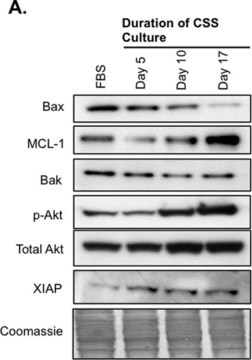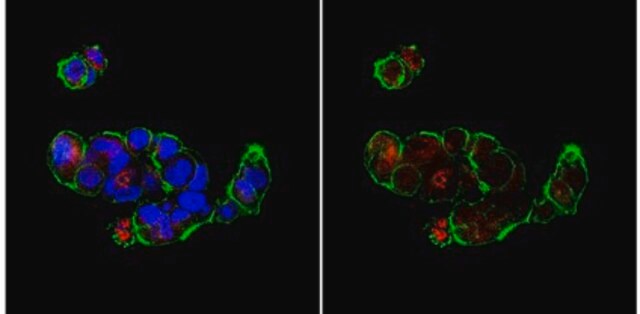ABC12
Anti-Bak (NT) Antibody
from rabbit, purified by affinity chromatography
Sinônimo(s):
Apoptosis regulator BAK, BCL2-antagonist/killer 1, BCL2-like 7 protein, Bcl-2 homologous antagonist/killer, Bcl-2-like protein 7, pro-apoptotic protein BAK
About This Item
Produtos recomendados
fonte biológica
rabbit
Nível de qualidade
forma do anticorpo
affinity isolated antibody
tipo de produto de anticorpo
primary antibodies
clone
polyclonal
purificado por
affinity chromatography
reatividade de espécies
mouse, rat, human
técnica(s)
immunocytochemistry: suitable
immunohistochemistry: suitable
immunoprecipitation (IP): suitable
western blot: suitable
nº de adesão NCBI
nº de adesão UniProt
Condições de expedição
wet ice
modificação pós-traducional do alvo
unmodified
Informações sobre genes
human ... BAK1(578)
Descrição geral
Especificidade
Imunogênio
Aplicação
Immunoprecipitation Analysis: For unpurified antibodies. 10 µg from a previous lot immunoprecipitated Bak from 500 µg of NIH3T3 lysate.
Immunohistochemistry Analysis: 1:300 dilution from a previous lot detected Bak in kidney tissue.
Immunocytochemistry Analysis: 1:500 dilution from a previous lot detected Bak in HeLa, NIH/3T3, and A431 cells.
Qualidade
Western Blot Analysis: 0.5 µg/ml of this antibody detected Bak on 10 µg of Hek293 cell lysate.
Descrição-alvo
Ligação
Outras notas
Não está encontrando o produto certo?
Experimente o nosso Ferramenta de seleção de produtos.
recomendado
Código de classe de armazenamento
12 - Non Combustible Liquids
Classe de risco de água (WGK)
WGK 1
Ponto de fulgor (°F)
Not applicable
Ponto de fulgor (°C)
Not applicable
Certificados de análise (COA)
Busque Certificados de análise (COA) digitando o Número do Lote do produto. Os números de lote e remessa podem ser encontrados no rótulo de um produto após a palavra “Lot” ou “Batch”.
Já possui este produto?
Encontre a documentação dos produtos que você adquiriu recentemente na biblioteca de documentos.
Active Filters
Nossa equipe de cientistas tem experiência em todas as áreas de pesquisa, incluindo Life Sciences, ciência de materiais, síntese química, cromatografia, química analítica e muitas outras.
Entre em contato com a assistência técnica







